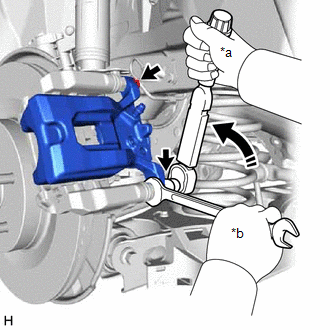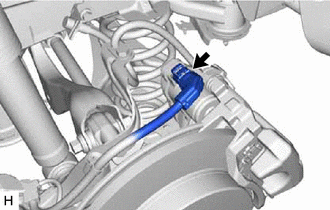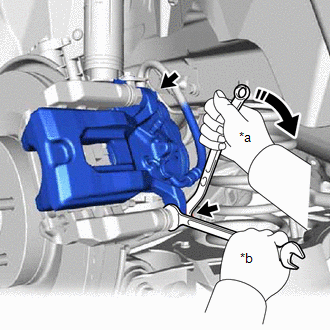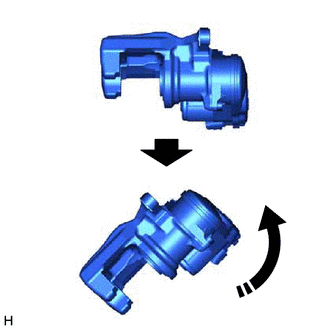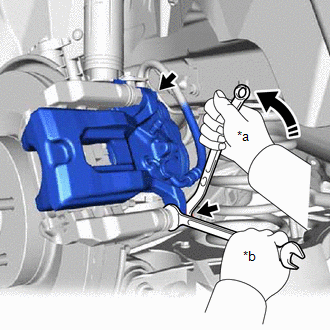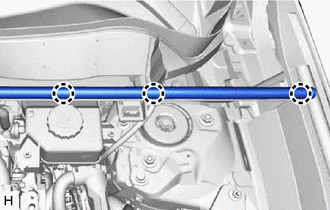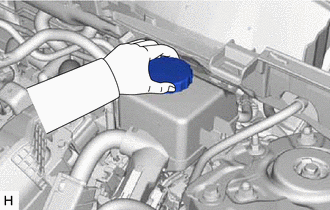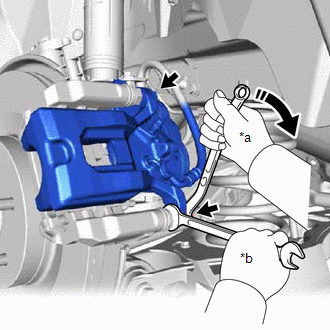| Last Modified: 01-30-2024 | 6.11:8.1.0 | Doc ID: RM100000001GILT |
| Model Year Start: 2019 | Model: RAV4 | Prod Date Range: [11/2018 - 12/2021] |
| Title: BRAKE (REAR): REAR BRAKE: INSTALLATION; 2019 - 2021 MY RAV4 RAV4 HV [11/2018 - 12/2021] | ||
INSTALLATION
CAUTION / NOTICE / HINT
NOTICE:
- Immediately after installing the brake pads, the braking performance may be reduced. Always perform a road test in a safe place while paying attention to the surroundings.
- After replacing the rear disc brake pads, the brake pedal may feel soft due to clearance between the rear disc brake pads and rear disc. Depress the brake pedal several times until the brake pedal feels firm.
- After replacing the rear disc brake pads, always perform a road test to check the braking performance and check for vibrations.
- When the brake pedal is first depressed after replacing the brake pads or pushing back the disc brake piston, DTC C1214 may be stored. As there is no malfunction, clear the DTC. (w/o vacuum brake booster)
- While the auxiliary battery is connected, even if the ignition switch is off, the brake control system activates when the brake pedal is depressed or any door courtesy switch turns on. Therefore, when servicing the brake system components, do not operate the brake pedal or open/close the doors while the auxiliary battery is connected. (w/o vacuum brake booster)
HINT:
- Use the same procedure for the RH side and LH side.
- The following procedure is for the LH side.
PROCEDURE
1. INSTALL REAR DISC
|
(a) Align the matchmarks of the rear disc and rear axle hub and bearing assembly, and install the rear disc. NOTICE: When replacing the rear disc with a new one, select the installation position where the rear disc has minimal runout. |
|
2. INSTALL REAR DISC BRAKE CYLINDER MOUNTING
(a) Install the rear disc brake cylinder mounting to the rear axle carrier sub-assembly with the 2 bolts.
Torque:
107 N·m {1091 kgf·cm, 79 ft·lbf}
3. INSTALL REAR DISC BRAKE BUSHING DUST BOOT
(a) Apply a light layer of lithium soap base glycol grease to the entire circumference of 2 new rear disc brake bushing dust boots.
HINT:
Apply more than 0.3 g (0.01 oz.) of lithium soap base glycol grease to each rear disc brake bushing dust boot.


|
Lithium Soap Base Glycol Grease |
(b) Install the 2 rear disc brake bushing dust boots to the rear disc brake cylinder mounting.
4. INSTALL REAR DISC BRAKE CYLINDER SLIDE PIN


|
Lithium Soap Base Glycol Grease |
(a) Apply a light layer of lithium soap base glycol grease to the contact surface of the rear No. 2 disc brake cylinder slide pin.
(b) Install a new rear disc brake cylinder slide bushing to the rear No. 2 disc brake cylinder slide pin.
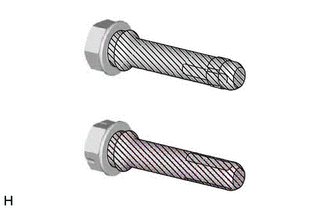

|
Lithium Soap Base Glycol Grease |
(c) Apply a light layer of lithium soap base glycol grease to the sliding part and the sealing surfaces of the rear No. 1 disc brake cylinder slide pin and rear No. 2 disc brake cylinder slide pin.
|
(d) Install the rear No. 1 disc brake cylinder slide pin and rear No. 2 disc brake cylinder slide pin to the rear disc brake cylinder mounting. |
|
(e) Push the rear No. 1 disc brake cylinder slide pin and rear No. 2 disc brake cylinder slide pin into each rear disc brake bushing dust boot to engage the pins to the boots.
5. INSTALL REAR DISC BRAKE PAD SUPPORT PLATE
(a) Install the 4 rear disc brake pad support plates to the rear disc brake cylinder mounting.
NOTICE:
Be sure to install each rear disc brake pad support plate in the correct position and direction.
6. INSTALL REAR DISC BRAKE ANTI-SQUEAL SHIM
7. INSTALL REAR DISC BRAKE PAD
(a) Install the 2 rear disc brake pads to the rear disc brake cylinder mounting.
NOTICE:
- Keep the friction surfaces of the rear disc brake pads and rear disc free from oil and grease.
- Install the rear disc brake pad so that the rear disc brake pad wear indicator plate is mounted on the lower side of the vehicle.
HINT:
If the rear disc brake pad has an identification mark, be sure to confirm the installation location.

|
*a |
Inner Side (Orange) |
|
*b |
Outer Side (Yellow green) |
8. INSTALL REAR DISC BRAKE CYLINDER ASSEMBLY
|
(a) Hold the 2 rear disc brake cylinder slide pins, and install the rear disc brake cylinder assembly to the rear disc brake cylinder mounting with the 2 new bolts in the order shown in the illustration. Torque: 34.3 N·m {350 kgf·cm, 25 ft·lbf} |
|
9. INSTALL PARKING BRAKE ACTUATOR ASSEMBLY LH
10. CONNECT NO. 2 PARKING BRAKE WIRE ASSEMBLY
11. CONNECT REAR FLEXIBLE HOSE LH
(a) Connect the rear flexible hose LH to the rear disc brake cylinder assembly with a new union bolt and a new gasket.
Torque:
29 N·m {296 kgf·cm, 21 ft·lbf}
NOTICE:
Install the rear flexible hose LH lock securely into the lock hole in the rear disc brake cylinder assembly.
12. CONNECT CABLE TO NEGATIVE AUXILIARY BATTERY TERMINAL (w/o Vacuum Brake Booster)
(a) Connect the reservoir level switch connector.
(b) Connect the cable to the negative (-) auxiliary battery terminal.
(c) Install battery hole cover.
(d) Install rear No. 2 floor board.
(e) Install deck board assembly.
(f) Turn the ignition switch on (READY).
(g) Depress the brake pedal and release it.
(h) Clear the DTCs.
13. BLEED BRAKE LINE
14. BLEED REAR DISC BRAKE CYLINDER ASSEMBLY (w/ Vacuum Brake Booster)
CAUTION:
If the rear disc brake cylinder assembly has been disassembled, perform air bleeding for the rear disc brake cylinder.
NOTICE:
- Perform air bleeding while maintaining the brake fluid level between the MAX and MIN lines on the brake fluid reservoir.
- Do not allow brake fluid to contact any painted surface. If brake fluid leaks onto any painted surface, immediately wash it off.
HINT:
- Use the same procedure for the RH and LH sides, except where indicated.
- The following procedure is for the LH side.
- While performing air bleeding of the rear disc brake assembly, the bolt can be reused during the bleeding procedure. After air bleeding is complete, replace the bolt with a new one.
(a) Perform the procedure to enter rear disc brake pad replacement mode 5 times.
|
(b) Disconnect the No. 2 parking brake wire assembly connector from the parking brake actuator assembly LH. |
|
|
(c) Hold the 2 rear disc brake cylinder slide pins and remove the 2 bolts and separate the rear disc brake cylinder assembly from the rear disc brake cylinder mounting.(*1) NOTICE: Keep the rear no. 2 disc brake cylinder slide pin free of foreign matter. |
|
|
(d) Hold the rear disc brake cylinder assembly horizontally, then tilt it 45° toward the bleeder plug side as shown in the illustration.(*2) |
|
|
(e) Temporarily install the rear disc brake cylinder assembly with the 2 bolts.(*3) |
|
(f) Remove the center cowl top ventilator louver.
(g) Remove the brake master cylinder reservoir filler cap.
(h) Add brake fluid to keep the level between the MIN and MAX lines of the reservoir while bleeding the brakes.
NOTICE:
- Make sure that there is sufficient brake fluid in the reservoir.
- If brake fluid leaks onto any painted surface, immediately wash it off.
- Do not remove the filter from the brake master cylinder reservoir and be sure to fill the brake master cylinder reservoir with new brake fluid to avoid any potential contamination of the brake system. Contamination, for example by dirt particles or mineral oil, could lead to functional brake problems.
(i) Depress the brake pedal several times, and then loosen the bleeder plug with the pedal depressed.(*4)
(j) When fluid stops coming out, tighten the bleeder plug and release the brake pedal.(*5)
(k) Repeat steps (*1) through (*5) 3 times.
NOTICE:
If there is still air in the system after performing steps (*1) through (*5) 3 times, repeat the steps (*1) through (*5) until the air has been bled.
(l) Tighten the bleeder plug completely.
Torque:
8.3 N·m {85 kgf·cm, 73 in·lbf}
(m) Install the rear disc brake cylinder assembly with a 2 new bolts.
Torque:
34.3 N·m {350 kgf·cm, 25 ft·lbf}
(n) Connect the No. 2 parking brake wire assembly connector to the parking brake actuator assembly LH.
(o) Inspect for brake fluid leaks.
(p) Inspect the brake fluid level in the reservoir.
(q) Install the brake master cylinder reservoir filler cap assembly.
(r) Install the center cowl top ventilator louver.
15. BLEED REAR DISC BRAKE CYLINDER ASSEMBLY (w/o Vacuum Brake Booster)
CAUTION:
If the rear disc brake cylinder assembly has been disassembled, perform air bleeding for the rear disc brake cylinder assembly.
HINT:
While performing air bleeding of the rear disc brake cylinder assembly, the bolts can be reused during the bleeding procedure. After air bleeding is complete, replace the bolts with new ones.
(a) Perform the procedure to enter rear disc brake pad replacement mode 5 times.
|
(b) Disconnect the No. 2 parking brake wire assembly connector from the parking brake actuator assembly LH. |
|
(c) Remove the center cowl top ventilator louver.
|
(1) Disengage the 3 hooks and separate the hood to cowl top seal from the cowl top ventilator louver sub-assembly. |
|
|
(2) Disengage the 2 claws and 2 guides to remove the center cowl top ventilator louver from the cowl top ventilator louver sub-assembly. |
|
|
(d) Remove the brake master cylinder reservoir filler cap assembly. |
|
(e) Add brake fluid to the brake master cylinder reservoir assembly until the brake fluid level is between the MAX and MIN lines on the brake master cylinder reservoir assembly.
NOTICE:
- Make sure that there is sufficient brake fluid in the brake master cylinder reservoir assembly.
- If brake fluid leaks onto any painted surface, immediately wash it off.
- Do not remove the filter from the brake master cylinder reservoir assembly and be sure to fill the brake master cylinder reservoir assembly with new brake fluid to avoid any potential contamination of the brake system. Contamination, for example by dirt particles or mineral oil, could lead to functional brake problems.
(f) Connect the Techstream to the DLC3 with the ignition switch off.
(g) Turn the ignition switch on (IG).
(h) Turn the Techstream on and enter the following menus: Chassis / ABS/VSC/TRAC / Air Bleeding.
Chassis > ABS/VSC/TRAC > Utility
|
Tester Display |
|---|
|
Air Bleeding |
HINT:
Do not apply the parking brake even if instructed by the Techstream.
|
(i) Hold the 2 rear disc brake cylinder slide pins and remove the 2 bolts and separate the rear disc brake cylinder assembly from the rear disc brake cylinder mounting. |
|
|
(j) Hold the rear disc brake cylinder assembly with the rear disc brake cylinder mounting horizontally, then tilt it 45° toward the bleeder plug side as shown in the illustration.(*2) |
|
(k) Temporarily install the rear disc brake cylinder assembly with the rear disc brake cylinder mounting to the rear axle carrier sub-assembly with the 2 bolts.(*3)
(l) Using the Techstream, perform air bleeding.(*4)
(m) Follow the Techstream instructions to bleed the air from the brake fluid.(*5)
NOTICE:
Add brake fluid to keep the level between the MIN and MAX lines of the reservoir while bleeding the brake lines.
(n) Repeat steps (*1) through (*5) 3 times.
NOTICE:
If there is still air in the system after performing steps (*1) through (*5) 3 times, repeat the steps (*1) through (*5) until the air has been bled.
(o) Tighten the bleeder plug completely.
Torque:
8.3 N·m {85 kgf·cm, 73 in·lbf}
(p) Install the rear disc brake cylinder assembly with a new 2 bolts.
Torque:
34.3 N·m {350 kgf·cm, 25 ft·lbf}
(q) Connect the No. 2 parking brake wire assembly connector to the parking brake actuator assembly.
(r) Clear the DTCs.
(s) Turn the Techstream off and turn the ignition switch off.
(t) Disconnect the Techstream from the DLC3.
(u) Inspect for brake fluid leaks.
(v) Inspect and adjust the brake fluid level in the brake master cylinder reservoir assembly.
(w) Install the brake master cylinder reservoir filler cap assembly.
(x) Install the center cowl top ventilator louver.
16. INSTALL REAR WHEEL
17. NORMAL CONDITION RECOVERY
|
|
|
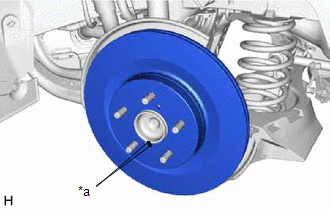

![2019 - 2021 MY RAV4 RAV4 HV [11/2018 - 12/2021]; MAINTENANCE: REAR DISC BRAKE PAD: INSTALLATION+](/t3Portal/stylegraphics/info.gif)
